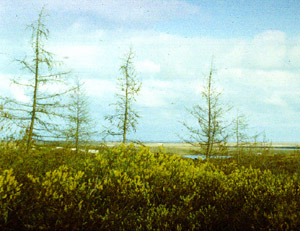|
|

The world's northernmost forest, of Larix gmelinii
at Ary-Mas, Taimyr Peninsula. There are 2 isolated groves, separated
from the timberline by 200 km of tundra [Vladimir Dinets].
Common Names
Larch [English], mélèze, mélèze laricin [French:] (1), lärche [German], larice [Italian], listvennits [Russian], KARAMATSU [Japanese], LUÒ YÈ SONG [Chinese].Taxonomic notes
Syn: Pinus Linnaeus p.p.; Abies A. L. de Jussieu (non Miller) (6).Larix is the type genus of Pinaceae subfamily Laricoideae, which also includes Cathaya and Pseudotsuga (7, 9, 10).
Although the synonymy is rather complex, there seems to be a general agreement that the genus contains about a dozen taxa. The European and North American species and varieties are generally agreed upon, while there is some debate about assigning specific, subspecific or varietal ranks to the Asian taxa. Such debate has principally involved L. sibirica and L. gmelinii , which together have a vast range including a small disjunct region (sometimes segregated from L. gmelinii as L. principis-rupprechtii ) and very extensive zones of hybridization with each other and with intraspecific varieties (3). The taxonomic uncertainties are partly due to the lack of a recent monographic treatment of Larix (the last were in 1930 [2] and [in a Russian paper not then readily available in the west] 1972 [8]). Moreover, there are political and linguistic problems involved in sorting out taxa native to remote areas of Russia and China.
Nonetheless, Bobrov (8) and LePage and Basinger (5) suggest the following phylogenetic tree for Larix (modified):
| Ancestral Larix | ||
| A. | Species with exserted bracts (Sect. Multiseriales Patschke; type L. griffithiana ): | |
| 1. | L. occidentalis & L. lyallii | |
| 2. | L. potaninii, L. griffithiana, L. himalaica, L. mastersiana | |
| B. | Species with non-exserted bracts (Sect. Larix ; type L. decidua ): | |
| 1. | L. laricina | |
| 2. | L. decidua | |
| 3. | L. sibirica | |
| 4. | L. gmelinii, L. kaempferi | |
Description
Deciduous trees with sparse, open crowns. Bark silver-gray to gray-brown on young trees, becoming reddish brown to brown, smooth initially, scaly to thickened and furrowed with age. Branches whorled; shoots strongly dimorphic; short (spur) shoots prominent on twigs 2 years or more old, each bearing leaves (needles), and often pollen cone, or seed cone; lateral long shoots (sylleptic branches) sometimes produced by current-year growth increments; leaf scars many. Buds rounded. Leaves in tufts of 10-60 on short (spur) shoots or borne singly on 1st-year long shoots, deciduous, ± flattened, with abaxial keel, sessile, base decurrent, sheath absent, apex pointed or rounded; resin canals 2. Pollen cones solitary, ovoid-cylindric, yellowish. Seed cones green, red or purple, maturing pale to dark brown in 4-7 months, persisting several years after seed release, erect, globose to ovoid, terminal on short shoots or lateral on 1-year-old long shoots, on a short leafy peduncle; scales persistent, circular to oblong-obovate, thin, tough and leathery, lacking apophysis and umbo; bracts included or exserted. Seeds winged; cotyledons 4-6. x =12" (1, 11).Range
Sect. Larix occurs in boreal circumpolar lowlands in Alaska, Canada and Russia, and at moderate to high altitudes in mountains south to NE USA, the Alps of Europe, Mongolia, NE China, N Korea and C Japan. Sect. Multiseriales occurs at high to very high altitudes in the Sino-Himalayan mountain system and the central Rocky Mts. (4, 5).Big Tree
See Larix occidentalis .Oldest
See Larix lyallii .Dendrochronology
All species have been utilized, principally for dendroclimatic reconstruction, although there has been recent use of the North American and European taxa in ecological and ecophysiological research.Ethnobotany
Some species of Larix are economically important for their hard, heavy, and decay-resistant wood (1). Top quality knot-free wood ('boatskin larch') is in great demand for yacht building (11). Despite their popularity as garden trees, only a few have received any horticultural attention; some cultivars exist for the most commonly cultivated Old World larches, L. decidua Miller and L. kaempferi (Lambert) Carrière, but almost none for the North American species (1). L. kaempferi is a popular bonsai subject in Japan (11).Observations
See the species descriptions.Remarks
Larix was the Roman name for larch (1).Larches are widely used in forestry in cool-temperate to subarctic zones. L. sibirica has proved the most successful tree for use in Greenland, but L. decidua and L. kaempferi have received the greatest international attention. Most if not all hybrid combinations attempted have been successfully created; the hybrid L. decidua × L. kaempferi ( L. × marschlinsii Coaz, syn. L. × eurolepis Henry nom. illeg. ) is an important forest tree in Britain.
Citations
(1) William H. Parker at the Flora of North America web site .(2) Ostenfeld & Syrach Larsen 1930 .
(3) Milyutin & Vishnevetskaia 1995 .
(4) Schmidt & McDonald 1995 .
(5) LePage, Ben A. and James F. Basinger. 1995. The evolutionary history of the genus Larix (Pinaceae). P.19-29 in Schmidt & McDonald 1995 .
(6) Dallimore & Jackson 1967 .
(7) Farjon 1990 .
(8) E. G. Bobrov 1972. Kratkiy obzor vidov Listvennits - Synopsis specierum generis Larix Miller. Novit. Syst. Pl. Vasc. 9: 4-15. [In Russian & Latin]
(9) M. P. Frankis 1989. Generic inter-relationships in Pinaceae. Notes Roy. Bot. Gard. Edinburgh 45: 527-548.
(10) Li Lin-Chu 1993. Studies on the karyotype and systematic position of Larix Mill. (Pinaceae). Acta Phytotax. Sinica 31: 405-412.
(11) M.P. Frankis, pers. comm. 26-Feb-1999.
This page co-edited with Michael P. Frankis, Feb-1999.
See also:
Gower, Stith T., and James H. Richards. 1990. Larches: deciduous conifers in an evergreen world. BioScience 40:818-826.
Schmidt-Vogt, H. 1977. Die Fichte; Ein Handbuch in zwei Banden. Band I: Taxonomie, Verbreitung, Morphologie, Íkologie, Waldgesellschaften. Hamburg - Berlin (cited in (7)).
Larix | Pinaceae | home
This page is from the Gymnosperm Database
URL: http://www.geocities.com/~earlecj/pi/la/index.htm
Edited by Christopher J. Earle
E-mail:
earlecj@earthlink.com
Last modified on 6-Feb-2000